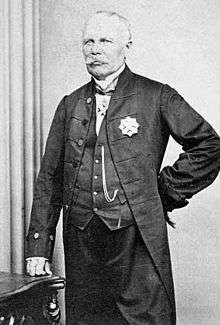L'Islet (Province of Canada electoral district)
L'Islet was an electoral district of the Legislative Assembly of the Parliament of the Province of Canada, in Canada East, on the south shore of the Saint Lawrence River, north-east of Quebec City. It was created in 1841 and was based on the previous electoral district of the same name for the Legislative Assembly of Lower Canada. It was represented by one member in the Legislative Assembly.
| Defunct pre-Confederation electoral district | |
|---|---|
| Legislature | Legislative Assembly of the Province of Canada |
| District created | 1841 |
| District abolished | 1867 |
| First contested | 1841 |
| Last contested | 1863 |
The electoral district was abolished in 1867, upon the creation of Canada and the province of Quebec.
Boundaries
The Union Act, 1840 merged the two provinces of Upper Canada and Lower Canada into the Province of Canada, with a single Parliament. The separate parliaments of Lower Canada and Upper Canada were abolished.[1]
The Union Act provided that the pre-existing electoral boundaries of Lower Canada and Upper Canada would continue to be used in the new Parliament, unless altered by the Union Act itself.[2] The L'Islet electoral district of Lower Canada was not altered by the Act, and therefore continued with the same boundaries which had been set by a statute of Lower Canada in 1829:
L'Islet electoral district was located on the south shore of the Saint Lawrence, to the north-east of Quebec City (now in L'Islet Regional County Municipality). The elections were held in the town of L'Islet.[4]
Members of the Legislative Assembly
L'Islet was represented by one member in the Legislative Assembly.[5]
The following were the members of the Legislative Assembly from L'Islet.[6]
| Parliament | Years | Member | Party[7] | |
|---|---|---|---|---|
| 1st Parliament 1841–1844 |
1841–1844 | Étienne-Paschal Taché |  |
Groupe canadien-français |
Abolition
The district was abolished on July 1, 1867, when the British North America Act, 1867 came into force, splitting the Province of Canada into Quebec and Ontario.[8] It was succeeded by electoral districts of the same name in the House of Commons of Canada[9] and the Legislative Assembly of Quebec.[10]
References
- Union Act, 1840, 3 & 4 Vict., c. 35, s. 2.
- Union Act, 1840, ss. 16, 18.
- An Act to make a new and more convenient subdivision of the Province into Counties, for the purpose of effecting a more equal Representation thereof in the Assembly than heretofore, SLC 1829, c. 73, s. 1, para. 5.
- An Act to make a new and more convenient subdivision of the Province into Counties, for the purpose of effecting a more equal Representation thereof in the Assembly than heretofore, SLC 1829, c. 73, s. 3.
- Union Act, 1840, s. 18.
- J.O. Côté, Political Appointments and Elections in the Province of Canada, 1841 to 1860, (Quebec: St. Michel and Darveau, 1860), pp. 43-58.
- For party affiliations, see biographies of individual members: Québec Dictionary of Parliamentary Biography, from 1764 to the present.
- British North America Act, 1867 [now the Constitution Act, 1867, s. 6.
- Constitution Act, 1867, s. 40, para. 2
- Constitution Act, 1867, s. 80.
![]()